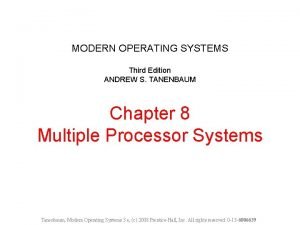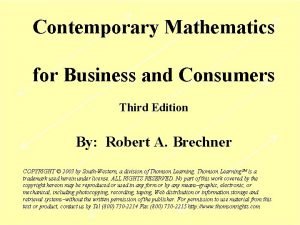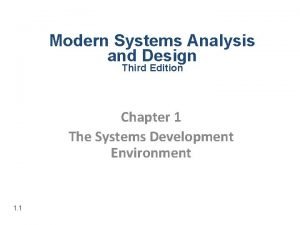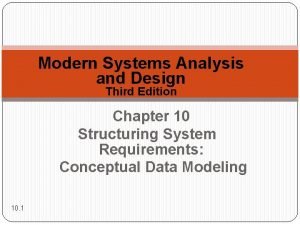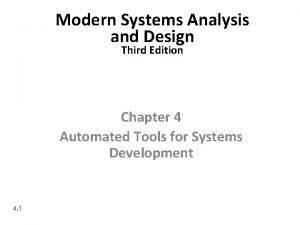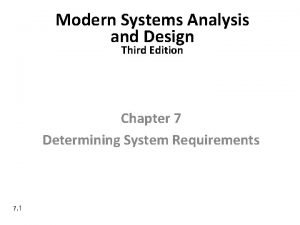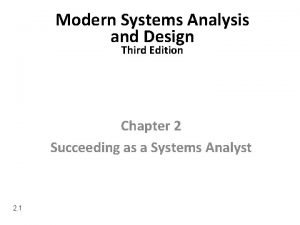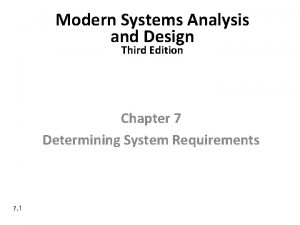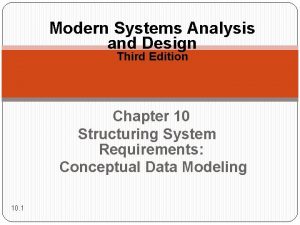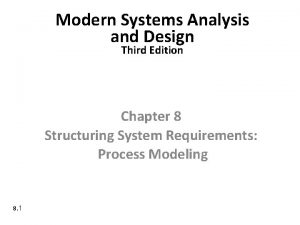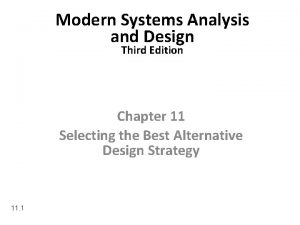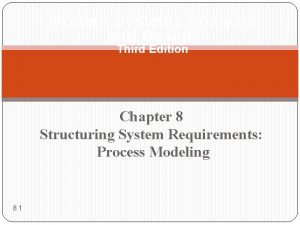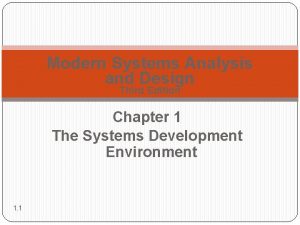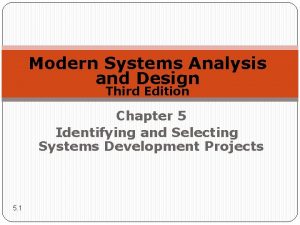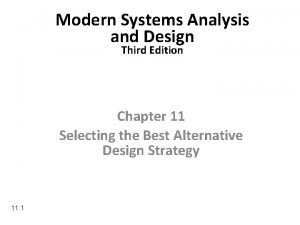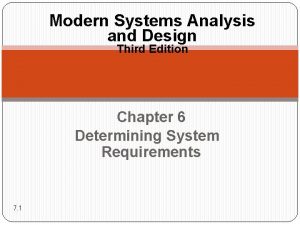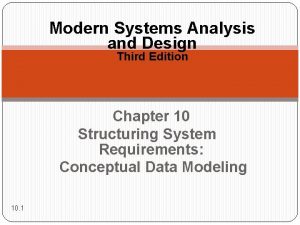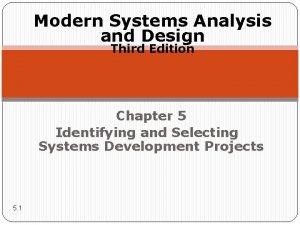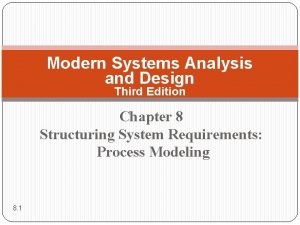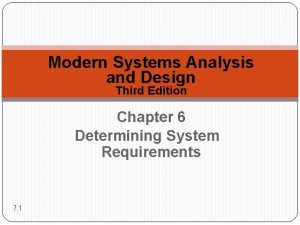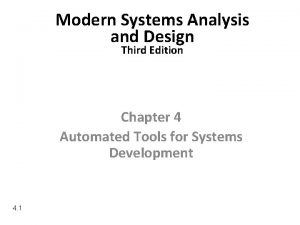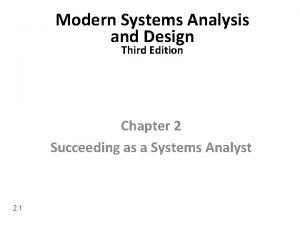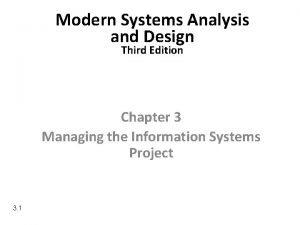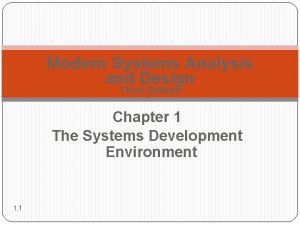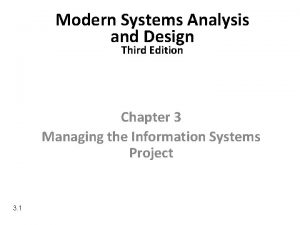Modern Systems Analysis and Design Third Edition Chapter

























- Slides: 25

Modern Systems Analysis and Design Third Edition Chapter 12 Designing Databases 12. 1

Purpose of Database Design • Structure the data in stable structures, called normalized tables – Not likely to change over time – Minimal redundancy • Develop a logical database design that reflects actual data requirements that exists in forms and reports • Develop a logical database design from which a physical database design can be developed • Translate a relational database model into a technical file and database design that balances several performance factors • Choose data storage technologies that will efficiently, accurately and securely process database activities 12. 2

Process of Database Design • Logical Design – – Based upon the conceptual data model Four key steps 1. Develop a logical data model for each known user interface for the application using normalization principles 2. Combine normalized data requirements from all user interfaces into one consolidated logical database model 3. Translate the conceptual E-R data model for the application into normalized data requirements 4. Compare the consolidated logical database design with the translated E-R model and produce one final logical database model for the application 12. 3

Process of Database Design • Physical Design – – Based upon results of logical database design Key decisions 1. Choosing storage format for each attribute from the logical database model 2. Grouping attributes from the logical database model into physical records 3. Arranging related records in secondary memory (hard disks and magnetic tapes) so that records can be stored, retrieved and updated rapidly 4. Selecting media and structures for storing data to make access more efficient 12. 4

Deliverables and Outcomes • Logical database design must account for every data element on a system input or output • Normalized relations are the primary deliverable • Physical database design results in converting relations into files 12. 5

Relational Database Model • Data represented as a set of related tables or relations • Relation – A named, two-dimensional table of data. Each relation consists of a set of named columns and an arbitrary number of unnamed rows; column – attribute; row – entity instance (record) – Properties of relations Entries in cells are simple Entries in columns are from the same set of values Each row is unique The sequence of columns can be interchanged without changing the meaning or use of the relation • The rows may be interchanged or stored in any sequence • • • Well-Structured Relation – A relation that contains a minimum amount of redundancy and allows users to insert, modify and delete the rows without errors or 12. 6 inconsistencies

Normalization The process of converting complex data structures into simple, stable data structures • Normalization is based on well-accepted principles and rules There are many rules and two such rules are: • Second Normal Form (2 NF) – Each nonprimary key attribute is identified by the whole key (called full functional dependency) • Third Normal Form (3 NF) – Nonprimary key attributes do not depend on each other (called transitive dependencies) • The result of normalization is that every nonprimary key attribute depends upon the whole primary key • 12. 7

Functional Dependencies and Primary Keys • Functional Dependency – A particular relationship between two attributes. For a given relation, attribute B is functionally dependent on attribute A if, for every valid value of A, that value of A uniquely determines the value of B; represented as A B – Functional dependence of B on A means that there can be only one value of B for each value of A – Instances (or sample data) in a relation do not prove the existence of a functional dependency – Knowledge of problem domain is most reliable method for identifying functional dependency • Primary Key – An attribute whose value is unique across all occurrences of a relation 12. 8

Functional Dependencies and Primary Keys • Second Normal Form (2 NF) – A relation is in second normal form (2 NF) if any of the following conditions apply: • The primary key consists of only one attribute • No nonprimary key attributes exist in the relation • Every nonprimary key attribute is functionally dependent on the full set of primary key attributes • Conversion to second normal form (2 NF) – To convert a relation into 2 NF, decompose the relation into new relations using the attributes, called determinants, that determine other attributes – The determinants become the primary key of the new relation 12. 9

Functional Dependencies and Primary Keys • Third Normal Form (3 NF) – A relation is in third normal form (3 NF) if it is in second normal form (2 NF) and there are no functional (transitive) dependencies between two (or more) nonprimary key attributes • Foreign Key – An attribute that appears as a nonprimary key attribute in one relation and as a primary key attribute (or part of a primary key) in another relation • Referential Integrity – An integrity constraint specifying that the value (or existence) of an attribute in one relation depends on the value (or existence) of the same attribute in another relation 12. 10

Transforming E-R Diagrams into Relations • It is useful to transform the conceptual data model into a set of normalized relations • Steps – Represent entities – Represent relationships – Normalize the relations – Merge the relations • Represent Entities – Each regular entity type in E-R diagram is transformed into a relation – The identifier of the entity type becomes the primary key of the corresponding relation – The primary key must satisfy the following two conditions a. The value of the key must uniquely identify every row in the relation b. The key should be nonredundant 12. 11

Transforming E-R Diagrams into Relations • Represent Relationships – Binary one-to-many (1: N) Relationships • Add the primary key attribute (or attributes) of the entity on the one side of the relationship as a foreign key in the relation on the right side • The one side migrates to the many side – Binary or Unary one-to-one (1: 1) Relationship • Three possible options a. Add the primary key of A as a foreign key of B b. Add the primary key of B as a foreign key of A c. Both of the above 12. 12

Transforming E-R Diagrams into Relations – – – 12. 13 Binary and Higher M: N relationships • Create another relation and include primary keys of all relations as primary key of new relation Unary 1: N Relationships • Relationship between instances of a single entity type • Utilize a recursive foreign key – A foreign key in a relation that references the primary key values of that same relation Unary M: N Relationships • Create a separate relation • Primary key of new relation is a composite of two attributes that both take their values from the same primary key

12. 14

Transforming E-R Diagrams into Relations • Merging Relations (View Integration) – Purpose is to remove redundant relations – View Integration Problems • Synonyms – Two different names used for the same attribute – When merging, get agreement from users on a single, standard name • Homonyms – A single attribute name that is used for two or more different attributes – Resolved by creating a new name • Dependencies between nonkeys – Dependencies may be created as a result of view integration – In order to resolve, the new relation must be normalized 12. 15

Physical File and Database Design • 12. 16 The following information is required – Normalized relations, including volume estimates – Definitions of each attribute – Descriptions of where and when data are used, entered, retrieved, deleted and updated (including frequencies) – Expectations or requirements for response time and data integrity – Descriptions of the technologies used for implementing the files and database

Designing Fields • Field – The smallest unit of named application data recognized by system software – Each attribute from each relation will be represented as one or more fields • Choosing data types – Data Type • A coding scheme recognized by system software for representing organizational data – Four objectives • Minimize storage space • Represent all possible values of the field • Improve data integrity of the field • Support all data manipulations desired on the field – Calculated (or computed or derived) fields • A field that can be derived from other database fields 12. 17

Methods of Controlling Data Integrity • Default Value – A value a field will assume unless an explicit value is entered for that field • Range Control – Limits range of values which can be entered into field • Referential Integrity – An integrity constraint specifying that the value (or existence) of an attribute in one relation depends on the value (or existence) of the same attribute in another relation • Null Value – A special field value, distinct from 0, blank, or any other value, that indicates that the value for the field is missing or otherwise unknown 12. 18

Designing Physical Tables • Relational database is a set of related tables • Physical Table – A named set of rows and columns that specifies the fields in each row of the table • Design Goals – Efficient use of secondary storage (disk space) • Disks are divided into units that can be read in one machine operation • Space is used most efficiently when the physical length of a table row divides close to evenly with storage unit – Efficient data processing • Data are most efficiently processed when stored next to each other in secondary memory 12. 19

Designing Physical Tables • Denormalization – – The process of splitting or combining normalized relations into physical tables based on affinity of use of rows and fields Partitioning • Capability to split a table into separate sections • Oracle 8 i implements three types – Range – partitions defined by non overlapping range of values – Hash – table row assigned to partition by an algorithm – Composite – combines range and hash partitioning 12. 20 – Optimizes certain operations at the expense of others – Denormalization • Three common situations where denormalization may be used 1. Two entities with a one-to-one relationship 2. A many-to-many relationship with nonkey attributes 3. Reference data

Designing Physical Tables • Arranging Table Rows – Physical File • A named set of table rows stored in a contiguous section of secondary memory – Each table may be a physical file or whole database may be one file, depending on database management software utilized • File Organization – A technique for physically arranging the records of a file – Objectives for choosing file organization 1. 2. 3. 4. 5. 6. 7. 12. 21 Fast data retrieval High throughput for processing transactions Efficient use of storage space Protection from failures or data loss Minimizing need for reorganization Accommodating growth Security from unauthorized use

Designing Physical Tables • – – 12. 22 Types of File Organization Sequential • The rows in the file are stored in sequence according to a primary key value • Updating and adding records may require rewriting the file • Deleting records results in wasted space Indexed • The rows are stored either sequentially or nonsequentially and an index is created that allows software to locate individual rows • Index – A table used to determine the location of rows in a file that satisfy some condition • Secondary Index – Index based upon a combination of fields for which more than one row may have same combination of values

Designing Physical Tables • Guidelines for choosing indexes – Specify a unique index for the primary key of each table – Specify an index foreign keys – Specify an index for nonkey fields that are referenced in qualification, sorting and grouping commands for the purpose of retrieving data • Hashed File Organization – The address for each row is determined using an algorithm 12. 23

12. 24

Designing Controls for Files • Backup Techniques – Periodic backup of files – Transaction log or audit trail – Change log • Data Security Techniques – Coding or encrypting – User account management – Prohibiting users from working directly with the data. Users work with a copy which updates the files only after validation checks 12. 25
 Modern systems analysis and design 7th edition
Modern systems analysis and design 7th edition Modern system analysis and design
Modern system analysis and design Modern systems analysis and design
Modern systems analysis and design A modern approach to systems analysis and design
A modern approach to systems analysis and design Distributed systems third edition
Distributed systems third edition Modern operating systems 3rd edition
Modern operating systems 3rd edition Modern operating systems tanenbaum 5th edition
Modern operating systems tanenbaum 5th edition Forward caries definition
Forward caries definition Caries profunda definition
Caries profunda definition System analysis and design kendall
System analysis and design kendall Principles of economics oxford fajar pdf
Principles of economics oxford fajar pdf Reaction of grignard reagent with acid chloride
Reaction of grignard reagent with acid chloride Organic chemistry third edition david klein
Organic chemistry third edition david klein Business mathematics third edition
Business mathematics third edition Fundamentals of corporate finance third canadian edition
Fundamentals of corporate finance third canadian edition Fundamentals of corporate finance, third canadian edition
Fundamentals of corporate finance, third canadian edition Lifespan development third edition
Lifespan development third edition Lifespan development third edition
Lifespan development third edition Essential cell biology chapter 1
Essential cell biology chapter 1 Graphical display
Graphical display Using mis (10th edition) 10th edition
Using mis (10th edition) 10th edition Using mis (10th edition) 10th edition
Using mis (10th edition) 10th edition Systems analysis & design in an age of options
Systems analysis & design in an age of options Gantt chart in system analysis and design
Gantt chart in system analysis and design Systems analysis and design in a changing world
Systems analysis and design in a changing world Systems analysis and design in a changing world
Systems analysis and design in a changing world




